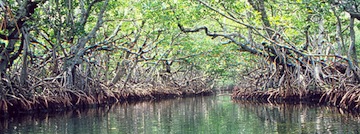331114-advancing mangroves.jpg

Mangrove forests are increasing in Texas. Credit: National Oceanic and Atmospheric Administration
One of the things that the debate about global climate change doesn’t always make clear is that it doesn’t necessarily take a big jump in temperature to create a big change in your surroundings. If you live close to the coasts of Louisiana, Florida, or especially Texas, for example, you may already be seeing one effect: an increase in mangrove forests. Mangroves are tough trees that live in warm coastal climates. A good, hard freeze can kill them, though, so here in the U.S., they’re most common in Florida, where winters are especially mild.
But mangrove forests are increasing in Texas as well, thanks to a small jump in winter’s low temperatures. Today, mangrove covers about 70 percent more of Texas coastal lands than it did a couple of decades ago. That’s crowded out the existing habitat in those regions, which was mostly salt marshes.
Projections say that winters are likely to get even warmer in the decades ahead. If they get warm enough, then mangrove forests could cover most of the coastlines of Texas, Louisiana, and Florida.
And that’s a bit of good news and bad news. It’s bad for the fish and birds that live in the salt marshes, because they might not be able to survive in a different habitat. But mangrove forests are also good habitats for fish and birds, and they provide a good buffer against storms. So the big challenge for us may be managing the growth of mangrove forests while finding ways to help the critters that live in the marshes adapt to the changing environment.
This episode was made possible by Texas Sea Grant

